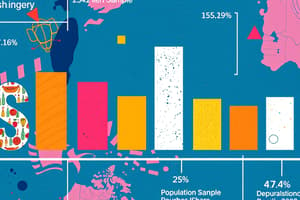Podcast
Questions and Answers
What are individuals in a study?
What are individuals in a study?
- Objects that are not part of the study
- The people or objects included in the study (correct)
- Only the people in a study
- None of the above
What is a variable?
What is a variable?
A characteristic of the individual to be measured or observed
Define quantitative variable.
Define quantitative variable.
A variable with a value or numerical measurement for which operations such as addition or averaging make sense
What describes a qualitative variable?
What describes a qualitative variable?
What is population data?
What is population data?
What is sample data?
What is sample data?
What does a population parameter refer to?
What does a population parameter refer to?
What is a sample statistic?
What is a sample statistic?
Define statistics.
Define statistics.
What does nominal level data consist of?
What does nominal level data consist of?
What is ordinal level data?
What is ordinal level data?
Define ratio level data.
Define ratio level data.
What is interval level data?
What is interval level data?
What is descriptive statistics?
What is descriptive statistics?
What is inferential statistics?
What is inferential statistics?
What is an example of a ratio variable?
What is an example of a ratio variable?
What type of variable is the time of first class?
What type of variable is the time of first class?
Define a stratified sample.
Define a stratified sample.
What is a convenience sample?
What is a convenience sample?
Which of the following describes a systematic sample?
Which of the following describes a systematic sample?
What is a sampling error?
What is a sampling error?
What is a non-sampling error?
What is a non-sampling error?
What is the purpose of a frequency table?
What is the purpose of a frequency table?
Class boundaries are possible data values.
Class boundaries are possible data values.
What does an outlier in a dataset represent?
What does an outlier in a dataset represent?
What is a Pareto Chart?
What is a Pareto Chart?
Define a circle chart or pie chart.
Define a circle chart or pie chart.
What is a stem and leaf display?
What is a stem and leaf display?
What is skewness in data?
What is skewness in data?
Match the data types with their definitions:
Match the data types with their definitions:
Flashcards are hidden until you start studying
Study Notes
Key Concepts in Statistics
- Individuals: Refers to the subjects or objects involved in a study, crucial for data collection.
- Variable: A measurable or observable characteristic of individuals within a study.
- Quantitative Variable: Represents numerical values where mathematical operations such as addition or averaging are applicable.
- Qualitative Variable: Categorizes individuals into groups based on characteristics (e.g., gender).
- Population Data: Comprehensive data collected from every individual of interest.
- Sample Data: Data obtained from a select number of individuals within a population.
- Population Parameter: A numerical summary that describes a specific feature of a population.
- Sample Statistic: A numerical summary derived from a sample, used to estimate population parameters.
Levels of Measurement
- Nominal Level: Data categorized by names or labels with no inherent order.
- Ordinal Level: Data arranged in order, but the differences between values are not meaningful.
- Interval Level: Data that can be ordered with meaningful differences between values, but lacks a true zero.
- Ratio Level: Similar to interval data but includes a true zero, making all mathematical operations valid.
Statistical Methods
- Descriptive Statistics: Techniques for organizing and summarizing data to describe sample or population characteristics.
- Inferential Statistics: Techniques that allow conclusions about a population based on sample data.
Types of Samples
- Simple Random Sample: Every individual has an equal chance of being selected from the population.
- Stratified Sample: Population divided into subgroups (strata) based on specific characteristics before sampling.
- Systematic Sample: Selection of individuals at regular intervals from an ordered list, starting from a random point.
- Convenience Sample: Utilizes readily available data to create a sample, potentially introducing bias.
- Cluster Sample: Population divided into clusters, and entire clusters are selected at random for inclusion in the sample.
Error Types in Sampling
- Sampling Error: Discrepancies between sample measurements and actual population metrics.
- Non-sampling Error: Errors arising from poor sample design or implementation.
Data Organization
- Frequency Table: A method to organize data into classes or intervals, showing the frequency of each class.
- Class Boundaries: Values defining the limits of data classes, established by adjusting class limits.
Data Visualization
- Pareto Chart: A bar graph that displays the frequency of events, arranged in descending order.
- Pie Chart: Visual representation of data where wedges represent proportions of a whole.
- Time Series Graph: Displays data points over time at regular intervals.
- Stem-and-Leaf Display: A method for organizing data that preserves the original values while facilitating analysis.
Data Distribution
- Mound-shaped Symmetrical: A distribution where both sides are identical when folded vertically; often bell-shaped.
- Uniform Distribution: All classes have equal frequency, creating a flat histogram.
- Skewness: Indicates the direction of the tail in a distribution; skewed left or right.
- Bimodal Distribution: A histogram with two classes that have the largest frequencies separated by at least one class.
Class Limit vs. Class Boundary
- Class Limits: Possible data values defining the span of a class.
- Class Boundaries: Values that fall between class limits, typically not representing actual data values.
Studying That Suits You
Use AI to generate personalized quizzes and flashcards to suit your learning preferences.




